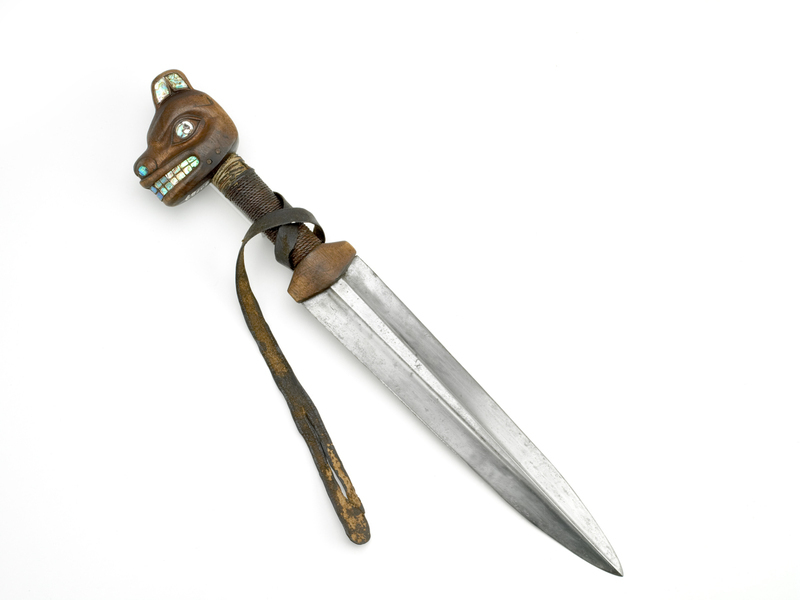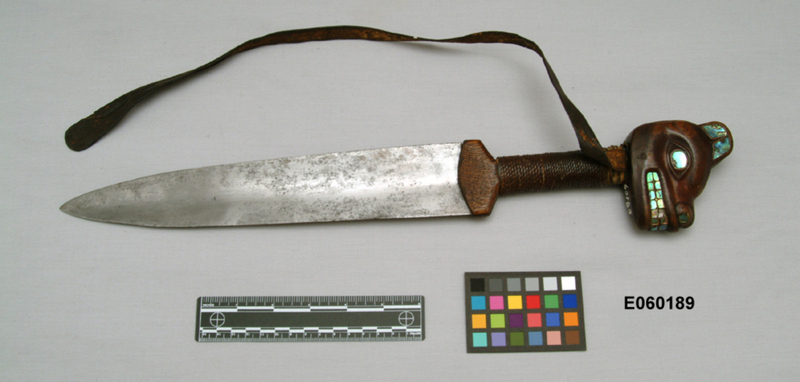Knife Or Dagger With Carved Wood Handle Item Number: E60189-0 from the National Museum of Natural History










Notes
FROM CARD: "LOAN. R. H. LOWIE MUSEUM DEC. 31, 1964. LOAN RETURNED FEB 15 1966. ILLUS.: HNDBK. N. AMER. IND., VOL. 7, NORTHWEST COAST, FIG. 12 RIGHT, PG. 217." Handbook caption identifies as a fighting knife, Northern Northwest Coast-style dagger, "The blade has a midline ridge on one surface; the other is concave. The carved wooden haft is wrapped in heavy twine. The crest is a bear, inlaid with abalone." FROM 19TH OR EARLY 20TH CENTURY EXHIBIT LABLE WITH CARD: "DAGGER.---DOUBLE-EDGED STEEL BLADE, VERY THICK DOWN THE MIDDLE AND BECOMING THINNER TOWARD THE EDGES. HANDLE OF WOOD, WITH A BEAR'S HEAD INLAID WITH HALIOTIS SHELL, CARVED ON THE END. THE HANDLE IS WRAPPED WITH CORD AND HAS ATTACHED A STRIP OF LEATHER WITH A SLIT CUT NEAR THE END, THROUGH WHICH THE MIDDLE FINGER IS PLACED AND THE LEATHER THEN TWISTED ABOUT THE WRIST, THUS SECURING THE WEAPON FIRM IN THE HAND, SO THAT THE WARRIOR NEVER LOOSES HIS DAGGER UNTIL DEATH. LENGTH OF BLADE, 19 1/2 INCHES; WIDTH OF BLADE, 11 1/2 INCHES. KOOTZNAHOO INDIANS (KOLUSCHAN STOCK), 60,189. ADMIRALTY ISLAND, ALASKA. COLLECTED BY JOHN J. MCLEAN."Source of the information below: Smithsonian Arctic Studies Center Alaska Native Collections: Sharing Knowledge website, by Aron Crowell, entry on this artifact http://alaska.si.edu/record.asp?id=128 , retrieved 3-12-2012: Clan knife or dagger, TlingitSee Smithsonian Arctic Studies Center Alaska Native Collections: Sharing Knowledge website, by Aron Crowell, entry on a different dagger which in the collections of the National Museum of the American Indian https://alaska.si.edu/record.asp?id=380 , retrieved 2-13-2022. It has this information on single-bladed daggers: Tlingit men wore the gwal.aa, or single-bladed dagger, in a sheath around the neck. The handle was carved to represent clan crests ... . The single-bladed dagger was a later type than the two-ended war knife and was not necessarily used for battle, but for personal defense.
Item History
- Made in Angoon, Admiralty Island, Alaska, USA ?; Kootznahoo, Alaska, USA ? or Killisnoo, Killisnoo Island, Alaska, USA ?
- Collected by Sgt. John J. McLean in Angoon, Admiralty Island, Alaska, USA ?; Kootznahoo, Alaska, USA ? or Killisnoo, Killisnoo Island, Alaska, USA ? during 1881
- Received on June 23, 1882
What
- Name
- Knife Or Dagger With Carved Wood Handle
- Identification Number
- E60189-0
- Type of Item
- knife
Who
- Culture
- Tlingit and Hutsnuwu
- Field Collector
- Sgt. John J. McLean
Where
- Holding Institution
- National Museum of Natural History
- Made in
- Angoon, Admiralty Island, Alaska, USA ?; Kootznahoo, Alaska, USA ? or Killisnoo, Killisnoo Island, Alaska, USA ?
- Collected in
- Angoon, Admiralty Island, Alaska, USA ?; Kootznahoo, Alaska, USA ? or Killisnoo, Killisnoo Island, Alaska, USA ?
When
- Collection Date
- during 1881
- Acquisition Date
- on June 23, 1882
Other
- Accession Number
- 011616